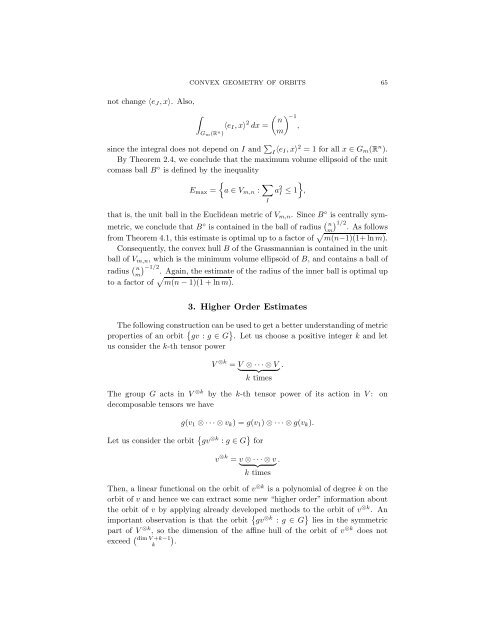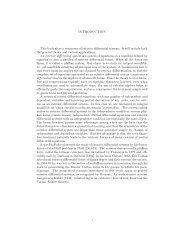You also want an ePaper? Increase the reach of your titles
YUMPU automatically turns print PDFs into web optimized ePapers that Google loves.
not change 〈eJ,x〉. Also,<br />
CONVEX GEOMETRY OF ORBITS 65<br />
�<br />
Gm(R n )<br />
〈eI,x〉 2 dx =<br />
� �−1 n<br />
,<br />
m<br />
since the integral does not depend on I and �<br />
I 〈eI,x〉 2 = 1 for all x ∈ Gm(R n ).<br />
By Theorem 2.4, we conclude that the maximum volume ellipsoid <strong>of</strong> the unit<br />
comass ball B◦ is defined by the inequality<br />
�<br />
Emax = a ∈ Vm,n : �<br />
radius � n<br />
m<br />
I<br />
a 2 I<br />
�<br />
≤ 1 ,<br />
that is, the unit ball in the Euclidean metric <strong>of</strong> Vm,n. Since B◦ is centrally symmetric,<br />
we conclude that B◦ is contained in the ball <strong>of</strong> radius � � n 1/2.<br />
m As follows<br />
from Theorem 4.1, this estimate is optimal up to a factor <strong>of</strong> � m(n−1)(1+ lnm).<br />
Consequently, the convex hull B <strong>of</strong> the Grassmannian is contained in the unit<br />
ball <strong>of</strong> Vm,n, which is the minimum volume ellipsoid <strong>of</strong> B, and contains a ball <strong>of</strong><br />
�−1/2. Again, the estimate <strong>of</strong> the radius <strong>of</strong> the inner ball is optimal up<br />
to a factor <strong>of</strong> � m(n − 1)(1 + lnm).<br />
3. Higher Order Estimates<br />
The following construction can be used to get a better understanding <strong>of</strong> metric<br />
properties <strong>of</strong> an orbit � gv : g ∈ G � . Let us choose a positive integer k and let<br />
us consider the k-th tensor power<br />
V ⊗k = V ⊗ · · · ⊗ V .<br />
� �� �<br />
k times<br />
The group G acts in V ⊗k by the k-th tensor power <strong>of</strong> its action in V : on<br />
decomposable tensors we have<br />
g(v1 ⊗ · · · ⊗ vk) = g(v1) ⊗ · · · ⊗ g(vk).<br />
Let us consider the orbit � gv ⊗k : g ∈ G � for<br />
v ⊗k = v ⊗ · · · ⊗ v .<br />
� �� �<br />
k times<br />
Then, a linear functional on the orbit <strong>of</strong> v⊗k is a polynomial <strong>of</strong> degree k on the<br />
orbit <strong>of</strong> v and hence we can extract some new “higher order” information about<br />
the orbit <strong>of</strong> v by applying already developed methods to the orbit <strong>of</strong> v⊗k . An<br />
important observation is that the orbit � gv⊗k : g ∈ G � lies in the symmetric<br />
part <strong>of</strong> V ⊗k , so the dimension <strong>of</strong> the affine hull <strong>of</strong> the orbit <strong>of</strong> v⊗k does not<br />
exceed � � dim V +k−1<br />
k .




